All fields are required
Posted in Food Safety,Our Blog,Salmonella on January 23, 2019

Salmonella is one of the leading causes of food poisoning in the United States. This is, in part, because of its ubiquity. The microbe can slip past your immune defenses by piggybacking on or in all sorts of foods. Some of them you’re probably aware of. Raw and undercooked chicken, for example, is often referred to as something you need to watch out for. It’s true, and it’s not just chicken; salmonella can travel in all kinds of animal products that haven’t been inoculated by heat. Nor is it just animal products. Veggies can carry salmonella, too. That’s right. Salmonella and Vegetables.
There’s lots of different ways that the microbe can hitch a ride. Firstly, and perhaps most obviously, it can travel on the surface of the plant. That can be en plein air, as the French say (it means “in open air,” more or less). Salmonella can also hide in dirt, or under the filmy secretions that some plants emit when they’ve been cut.
The salmonella bacterium doesn’t have be on the vegetable. As with the knight and the dragon that are sometimes used to teach prepositions, it can also be in, around, through, or about the vegetable. Previously, we’ve known about a few different ways that it can get inside. One is through cracks in the surface of the plant. Others include through stomata (the tiny pores which plants use to respire gas) or through hydrathodes (the similarly minuscule holes which some plants use to release water).
Now, thanks to new research out of the Indian Institute of Science, we understand another way that salmonella can get into a plant: through the roots. Scientists there discovered this through a series of experiments on tomato plants. It’s already been established that salmonella can live in other parts of the plant, like the leaves or fruiting bodies; we also know that other pathogens like E. coli have developed a range of strategies to get inside the root structure of a plant. Whether or not salmonella could also do so, however, was still in question.
Some microorganisms can get into the body of a plant by feeding on it. Salmonella, however, isn’t equipped to eat the materials that the outer layers of a plant are made from. That means that it needs to find a way to get in. We discussed a few of the ways that it can do this already – through pores like stomata or hydrathodes, for example, or by entering through tiny cracks in the fruit of the plant.
To colonize through the roots, salmonella needs to find a similar hole. That’s where lateral roots come in. The process of root formation is complex, and we’re not going to get too deep into the weeds here, but we’ll cover some essentials: the main roots of a plant run vertically, reaching down into the soil. Lateral roots branch off from those primary roots and reach out horizontally into the soil around the primary root.
The emergence of new lateral roots in the plant creates perforations in the protective outer layer of the plant’s primary root. As the lateral roots emerge perpendicularly, they tear tiny openings in the defenses of the plant. These apertures create a gap in the defenses of the primary root that are otherwise salmonella-proof. It’s a bit like a window opening – a window through which the root can grow outward, but one through which salmonella is also ready to slip inward. Once the lateral root has sprouted, these tiny openings are filled in around it, closing the window and re-sealing the outer layer of the plant’s roots at the newly created junction.
It’s through this tiny opening that salmonella can find a way into the lateral roots of the plant. Because it can’t feed on the materials that make up the outer layer, it lacks the enzymes needed to break into the plant on its own – it needs a window of opportunity, as it were, to find a way in. The opening created when a lateral root sprouts from the primary root is literally this window.
The experiments done by the scientists at the University of India saw that the salmonella bacteria bunched up around the emerging lateral roots of tomato plants after being introduced to the roots during the test. Plants with more lateral roots also demonstrated higher concentrations of salmonella.
Once the salmonella has successfully colonized the root structure of the tomato plant, it can move around inside, spreading from the roots to other parts of the plant. Tomatoes harvested from plants whose roots were inoculated with salmonella during the test also displayed salmonella, indicating that the pathogen can move to different parts of the plant’s interior once it’s moved into the root structure.
Another finding of the study had to do with how plants respond to stress – specifically, the stress of trying to put down roots in soil with a high saline content. Salt can interfere with plant’s need to uptake moisture as it grows, so one strategy that tomato plants have adopted is branching out through (you guessed it) lateral roots. In salty soil, these extra lateral roots make the plant more susceptible to colonization by salmonella.
Salmonella is one of the lead causes of food poisoning in the United States – a regular nuisance and occasional serious danger that comes up on a daily basis here at MakeFoodSafe. Better understanding how salmonella infects plants could lead towards better prevention and quicker response to outbreaks in the future. The authors of the study hope to conduct similar investigations into the methods that salmonella uses to infect other fruits and vegetables as well.
By: Sean McNulty, Contributing Writer (Non-Lawyer)